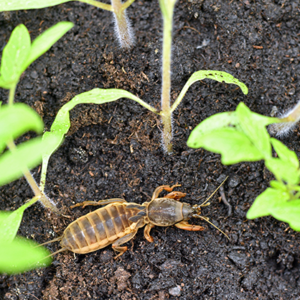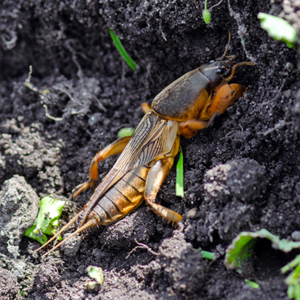Invasive mole crickets are a serious problem for many Pensacola homeowners. These unearthly-looking creatures look like they came from outer space. Unfortunately, the damage they cause to your lawn also seems out of this world. Read on and learn everything there is to know about the mole cricket, how to identify signs of mole cricket damage, and how to control these annoying creatures.
Types of Mole Crickets
In Florida, there are four species of mole crickets. Three of them are invasive and considered pests. These include the tawny, southern, and short-winged mole species. There is also another one that is native to the sunshine state: the northern mole cricket. This one is not considered a pest.
How to Identify a Mole Cricket
While they have a very distinct look, mole crickets are hard to spot. They tunnel deep in the ground and only come out at night. Members of the cricket family look like a cross between a cricket and a lobster. They are approximately one to two inches long, gray-brown in coloring, have velvet-type bodies, and large, clawed front legs.
The Life Cycle of The Mole Cricket
Like many other insects, they start as eggs, pass through several immature nymph stages, then become adults. As spring emerges, they become adults just in time for mating season. The male mole cricket constructs a mating chamber at the surface end of their tunnel and starts producing a song to attract his mate. Sound romantic? Unfortunately for him, once he has found his beloved, the male dies shortly after. The female then searches for a place to lay their new eggs, digging up to ten inches to secure them.
Why Are These Insects So Harmful?
These pesky critters like to feed on the roots of our Pensacola warm-season grasses. These include bahiagrass, bermudagrass, St. Augustinegrass, centipedegrass, and zoysia. But the severe damage they cause is through their tunneling, often close to the soil surface. Their network of tunnels loosens the topsoil uprooting the plants, which then dry out and die. Most cricket tunneling and feeding damage appear as ugly brown patches of dying or dead grass typically replaced by opportunistic weeds.
Other signs and symptoms of mole damage include:
- Small mounds of dirt scattered on the soil surface
- Raised soil
- Spongy grass
- Brown, dry, or dead areas of patchy grass
How to Check For Mole Crickets
The damage mole crickets cause often mimics the symptoms of other lawn problems, including certain diseases. Mole crickets also lurk underground, making them hard to spot. Therefore, if you want to be sure it’s a mole cricket problem you have, mix 1.5 ounces of liquid dishwashing soap into 2 gallons of water. In the morning or late evening, pour the mixture over an area of one to two square feet. If you see these alien-like creatures come to the surface, you know you have mole crickets.
When Are Mole Crickets Most Active in Pensacola
In Pensacola, mole crickets do most of their damage between March and June and late August through October. They typically have one generation per year, with eggs laid between April and May. Mole crickets are nocturnal, sleeping during the day and feasting, tunneling, and flying at night. This is another reason they can be hard to spot, and often the damage they cause is found too late.
Mole Cricket Prevention
Mole crickets can damage any turfgrass species, but they particularly like the taste of Bahia grass and bermudagrass. They are also attracted to lawns with an abundance of thatch which is a thick mat of grass clippings, organic matter, and other debris on the soil’s surface. Keeping your grass healthy with proper mowing, irrigation, and fertilization can help decrease thatch and keep your lawn healthy and strong. A stronger lawn can better ward off pest infestations when they occur. Having your turf properly aerated once a year can also decrease thatch. But what if it’s already too late and your Pensacola lawn has already been damaged by mole crickets?
Stop Mole Crickets With Insect and Pest Control From Lawn Master
Lawn Master understands the different types of grass and pests that live on Pensacola’s residential and commercial lawns. We provide an insect and pest control service to help keep your yard insect and pest-free. As part of our insect and pest management service, we include a free lawn evaluation. This allows our trained and knowledgeable technicians to determine the specific types of pests damaging your lawn. We will then devise a plan of action. We offer insect and pest control year-round, and it can be purchased separately.
Learn more about our insect and pest control by contacting us online or giving us a call at 850-476-1601.
While here, learn more about our lawn care program designed to keep your lawn healthy and strong, as well as our aeration services designed to keep thatch from suffocating your lawn. Call us today.
For more tips and ideas like the article above, visit and follow our monthly blogs.